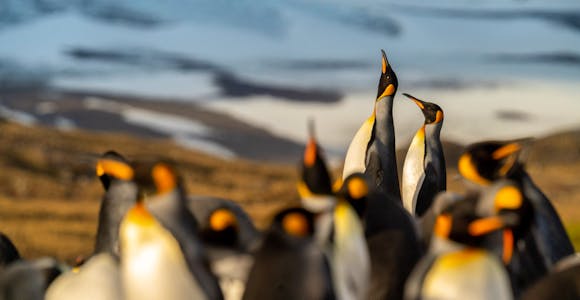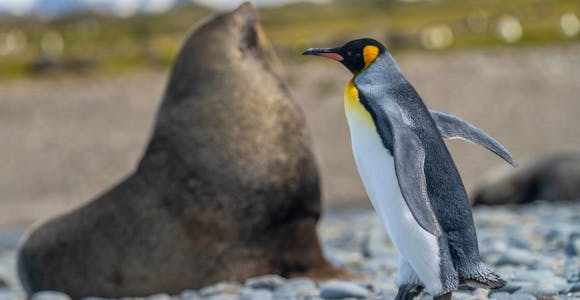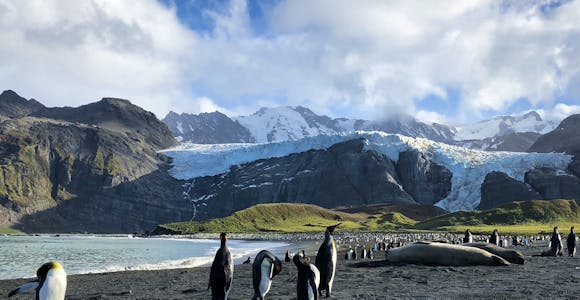Our January Featured Offers
At Swoop we proudly work with every operator in the Antarctic industry.
This means we can find you the latest deals and with our Price Match Promise you know you're getting the very best price.

Price Match Promise - We’ll match any price you find elsewhere for the same trip
At Swoop we proudly work with every operator in the Antarctic industry.
This means we can find you the latest deals and with our Price Match Promise you know you're getting the very best price.


King penguins at Fortuna Bay
If there's one reason that wildlife lovers put South Georgia so high on their wish list, it's the penguins. We don't blame them. Four species of penguins breed on South Georgia: kings, macaronis, gentoos and chinstraps. Of these, the most numerous are the macaroni penguins, with their exuberant yellow eyebrow feathers, but it's king penguins that are the real showstoppers.
The king penguin colonies at St Andrews Bay, Salisbury Plain and Gold Harbour quite simply offer some of the most incredible birdwatching on the planet. Penguins accompany you from the moment you land on the beach all the way to the colonies where the birds are numbered in the hundreds of thousands. The noise is deafening, both from the trumpeting of the adults to the whistles of the chicks, who are present year-round.
Most visitors are lucky enough to spot all four penguin species on their trip to South Georgia, but it you want to tick them off in one go, cross your fingers for a landing at Cooper Bay, the only place on the island where all four species breed.

Fur seal pup on Prion Island
In terms of sheer biomass, the Antarctic fur seal is South Georgia's dominant species. They were hunted almost to extinction for their pelts in the early 19th century, but modern surveys have had trouble keeping track of their every growing numbers. New research published in 2023 suggests that the island is home to around 3.5 million fur seals, representing over 95% of the world's population.
It's a number that's easy to believe when you visit. In November and December the beaches are packed with males claiming their breeding territories, and their aggressive demeanour can sometimes make going ashore a real challenge. After this the shores froth with huge numbers of fur seal pups cute enough to launch a thousand internet memes – guides often refer to the seas here as being 'fur seal soup' there are so many of them.

A male elephant seal about to begin his summer moult
Half of all the world's southern elephant seals make their home around South Georgia, numbering perhaps 400,000 individuals. They spent most of their lives at sea, but in October the males come ashore to fight over great harems of females. The largest males are known as beachmasters, over 5m long and four tonnes in weight: often three times the size of the females. Jousts between competing males make a formidable sight.
Pups are born from November and grow fat until they are known as weaners. Adults return to shore after January for their annual moult, when they shed old skin in muddy wallows. During this time, few animals can match them for their moth-eaten appearance during this time – or their constant chorus of belches and farts.
A small number of Weddell seals breed at the very southern tip of South Georgia around Drygalski Fjord. Leopard seals are also sometimes seen on beaches, but they are summer visitors only and do not breed here.

A northern giant petrel takes to the sky
If you want proof of South Georgia's importance as a wildlife haven, look no further than the numbers of seabirds nesting here: a million pairs of white-chinned petrels, 6 million pairs of diving petrels and an almost unimaginable 25 million pairs of Antarctic prions. Sometimes you just won't know where to point your binoculars.
Although smaller in numbers, albatrosses are the charismatic seabirds that most visitors are keenest to see. Wandering albatrosses, the world's largest seabird, nest in several locations on the north of the island, and at certain time of the year can be seen on their nests at Prion Island. While on zodiac cruises elsewhere, lookout for the cliffside nests among the tussock of the grey-headed albatross, black-browed albatross and light-mantled albatross. Elsehul is one of the best locations for spotting albatross on the wing. The cliffs are also where you'll spot the nests of blue-eyed shags (imperial cormorants) and kelp gulls.
Other seabird species are more closely associated with the beaches. Where there are penguin colonies you'll find predatory brown skuas nesting nearby. Antarctic terns also favour the glacial outwash plains popular with king and gentoo penguins. Giant petrels (both the northern and southern variants) invariably scavenge around the beaches looking for carrion: a flock can reduce an elephant seal carcass to skin in just a few hours. Expect to see snowy sheathbills also pecking around; they're very curious and will investigate anything you've put on the ground.

Humpback whale comes up for air
South Georgia was where the Antarctic whaling industry was born in the early years of the 20th century and its seas were the first to be plundered of whales. In the last 50 years, numbers are slowly starting to recover.
Most astonishing of all are the humpback whales, whose numbers are now regarded as having almost completely returned to pre-whaling levels. They start to arrive from their tropical breeding grounds in November and are frequently sighted between South Georgia and Antarctica. Humpbacks are easily identified by their long white pectoral fins.
Fin whales – the second largest of the great whales – are also in residence at this time, particularly off the island’s southern coast, and their numbers are also believed to be on the rise. Look for the distinctive curved dorsal fin, and their asymmetric jaws (one is pale, the other dark).
Blue whales have been much slower to show signs of recovery and sightings remain rare. Their sheer bulk and small dorsal fin located well back on the body make them very distinctive.
The Southern Right Whale, the first whale to be driven almost to extinction, is making the slowest progress towards population recovery. Right whales are rarely seen, but if spotted are likely to be close to shore.
South Georgia can almost a bit overwhelming because you don’t know where to look – there’s so much wildlife and there’s so much going on at the same time! You need to just stand still for a long time and take it all in step by step.
Matias Polar wildlife guide

South Georgia pipit (Image: South Georgia Heritage Trust/Oli Prince)
Don't be surprised if you hear your guide getting excited about hearing the trill of bird song on a landing: they'll have just heard the call of the endemic South Georgia pipit, the world's most southerly songbird. It's something to celebrate as a few years ago they were reduced to just a few outlying islands due to predation of their nests by rats introduced during the whaling period. A five year, multi-million dollar habitat restoration programme led by the South Georgia Heritage Trust finally saw the island declared rat free in 2018. The pipit has been quick to recolonise the mainland, along with the lovely South Georgia pintail duck, another endemic. You might come here for the penguins, but spotting a train of ducklings following their mother is one of the most optimistic sights you can find on the whole island.
Many invasive plant species were also introduced accidentally by whalers, and efforts are ongoing to control and eradicate non-native species. The risk of accidentally transferring seeds from one location to another on the island is a key reason why biosecurity procedures must be strictly followed throughout the entirety of a visit.

South Georgia pintails (Image: South Georgia Heritage Trust/Oli Prince)
As a result of careful management overseen by the Government of South Georgia & the South Sandwich Islands, South Georgia is now regarded as that rarest of things: an ecosystem in recovery. The island's maritime protection zone extends 200 nautical miles, covers nearly one million square kilometres and is one of the most strictly monitored in the world. As a result, albatross mortality in these waters because of long-line fishing has been virtually eliminated, while quotas for krill fishing are set deliberately low for the protection of the species that depend on it.
Visitors may see the government's bright red ship Pharos that monitors fishing in its waters, as well as sometimes carrying out impromptu inspections of expedition cruise ships to ensure they are adhering to strict biosecurity protocols.
There is no best time to visit South Georgia as you are guaranteed animals in vast numbers at any time. The king penguin's unusual breeding cycle means that chicks are present throughout the year. From January, the island abounds in fur seal pups.
For a month-by-month guide to what the wildlife will be doing during your visit, see our page When to visit South Georgia.
Keen birders should check that their visit coincides with when Prion Island is accessible.
Prion Island is renowned for its nesting wandering albatross. Access to the island is strictly controlled; it's closed to all visitors between 20th November - 7th January inclusive to match the fur seal breeding season, so time your visit outside these dates if these beautiful birds are high on your wish list. Access is controlled by permit and not all expedition itineraries visit Prion Island, so if this is a top priority for your visit please let our specialists know so they can recommend the best suited trip for you.
Very close is the short answer! The sheer density of South Georgia’s wildlife and their lack of fear of man means that challenge isn't getting close to wildlife, it's giving them enough space. It's not uncommon to find yourself being approached by a curious penguin or a fur seal pup full of false bravado.
Maintain a distance of 5m from wildlife at all times, and 10m from the edge of penguin colonies. If an animal approaches you, slowly move away. Remember that wildlife on South Georgia always has the right of way and if anything you do causes an animal to change their behaviour, you're too close and should quietly move away.
Absolutely. On board you'll find a variety of guides with a wealth of wildlife experience to tell you more about the animals you're seeing – both while you're on shore and during dedicated talks on the ship. Expert guides are an integral part of the expedition cruise experience, so don't be surprised if your guides have a background in scientific research in the region as well as working with tourists.
Yes. South Georgia is a wildlife photographer's paradise so it attracts a higher than usual proportion of travellers who are seriously dedicated to their cameras. Landings are always planned to maximise your time on shore. Many ships will also have their own photography guide on board.
Such is the density of wildlife here however, the problem is not finding a subject to photograph, it's being overwhelmed with so many places to point your camera at!

From the epic king penguins colonies to the island's macaronis, gentoos and chinstraps, penguin are the reason so many people want to visit South Georgia.
Discover More
Even on an island that abounds with incredible wildlife encounters, the vast king penguin colony of St Andrews Bay is truly something special.
Discover More
With its amphitheatre-like mountains and large numbers of king penguins and elephant and fur seals, Salisbury Plain is as truly jaw-dropping as South Georgia gets.
Discover More
With its hanging glaciers towering over a beach dense with penguins and seals, few locations in South Georgia are as dramatic as Gold Harbour.
Discover MoreWe'll spend some time listening to your aspirations, then discuss the kind of experience that might suit you.
Next we'll discuss the options, shortlist the best trips for you and present you our impartial recommendations.
We'll place a 24 hour hold on your preferred option - without obligation - whilst we talk through the details.

